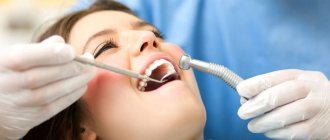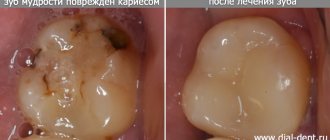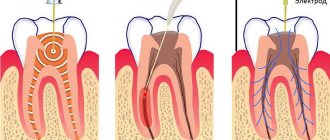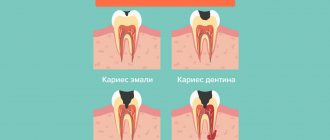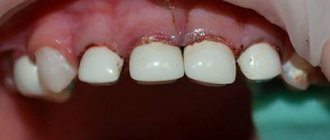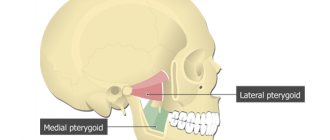Gangrenous pulpitis is a putrefactive inflammation of the pulp in the crown and root parts of the tooth, which is accompanied by the death of its tissues. This form is considered one of the most dangerous and neglected, and its characteristic feature is the destruction of the pulp.
Gangrenous pulpitis of the tooth
is a late stage of chronic pulpitis, resulting from the lack of treatment for a disease such as caries. It is characterized by such unpleasant manifestations as darkening of the tooth, the development of halitosis (bad breath), and aching pain symptoms. Most often, this form of pulpitis affects the chewing teeth of the lower jaw.
Filling made of light-curing material for classes I and V - 2,000 rubles.
Filling made of light-curing material in classes II, III, IV - 3,000 rubles.
Placing a temporary filling - 400 rubles.
Resection of the root apex (frontal group) - 6,500 rubles.
Resection of the root apex (chewing group) - RUB 9,000.
Mechanical and medicinal treatment of canals for periodontitis (1 canal) - 1,100 rubles.
Closing perforations (MTA) - RUB 6,500.
At CELT you can get advice from a dental specialist.
- The cost of a dental consultation is 1,000
- The cost of an orthodontist consultation is 2,000
Make an appointment
Gangrenous pulpitis: etiology
Gangrenous pulpitis occurs due to the penetration of putrefactive anaerobic bacteria into the pulp. At the same time, the routes of penetration can be different:
- A carious cavity that requires treatment;
- Incorrectly carried out treatment, in which the affected tissues reached the nerve of the tooth (pulpitis develops under the filling);
- Violations of the technique of preparing a tooth for a crown;
- Deep periodontal pockets;
- Destruction of the tooth to soft tissues with severe abrasion;
- Periodontitis of the adjacent tooth;
- Various tooth injuries;
- Diseases of an infectious nature in which microorganisms are transferred to dental tissues through blood and lymph.
Another reason for the development is exacerbation of gangrenous pulpitis
, which was not cured and over time developed into a chronic form.
How does the disease progress in adults?
The course of this disease in different patients can occur differently, which is explained by the following reasons:
- The causative agents of the disease can be different bacteria, which can be specific for each person;
- the course of the disease directly depends on the patient’s health, the strength of his immune system and the level of resistance to diseases;
- the presence or absence of infectious or other diseases.
The acute and chronic forms occur with differences, albeit not the most significant. Thus, the chronic form is characterized by pulp damage in both the coronal and root parts of the tooth. In addition, the root area begins to fill with granulation tissue. Then comes the stage of fibrosis, accompanied by an inflammatory process in the pulp. Large veins are affected by necrosis, and small ones become clogged with blood clots. It is not always possible to determine which form you are dealing with, so a high-quality and thorough examination is of particular importance.
Symptoms
Symptoms of gangrenous pulpitis depend on the form in which it occurs:
- Acute gangrenous pulpitis is characterized by the presence of deep ulcers that cover the entire pulp. Due to the destruction of the septum between the carious cavity and the pulp, the infection penetrates inside. The acute form is characterized by severe pain that occurs for no reason or as a result of a reaction to irritants in the form of hot or cold food;
- Chronic gangrenous pulpitis is characterized by a dirty-gray tint of the upper layers of the pulp and the tooth itself, and the presence of a large carious cavity. There is no bleeding. There are practically no symptoms of pain, but sometimes aching pain may occur, especially when exposed to irritants. There is a putrid odor from the mouth.
The course of the disease depends on the following factors:
- pathogenicity of microorganisms;
- pulp resistance;
- the patient's general health status;
- periodontal condition;
- body resistance;
- the presence of concomitant pathologies.
This means that the process of development of the disease directly depends on how healthy the patient’s body is: the stronger it is, the more time it takes for bacteria to have a negative effect. Taking into account the above, we can conclude that the disease is especially severe in children, since the resistance of the child’s body is much lower than that of an adult. Clinic of gangrenous pulpitis
may vary depending on whether the tooth cavity is open or closed. So, with an open cavity, the following symptoms are observed:
| Symptoms of an open cavity | Symptoms with a closed cavity |
|
|
Causes
The root cause of the development of gangrenous lesions is not even the infection itself, but the soil favorable for its development, formed against the background of a constant lack of nutrients and vitamins in the body, exhaustion, chronic diseases (in particular periodontal disease, untreated jaw injuries or infectious lesions of the soft tissues of the oral cavity), failure to comply with basic hygiene and lack of adequate medical care. And this entire complex of negative components is superimposed on the symbiosis of fusiforme Вasterien hervorgerufen and the Plaut-Vincenti spirochete, which ultimately leads to the development of gangrene.
Gangrenous pulpitis in children
Children are much less susceptible to this disease... However, if it occurs, its treatment requires considerable effort. Most often, young patients suffer from chronic pulpitis due to the fact that they cannot correctly explain the essence of the problem and the nature of the pain. This leads to the disease becoming chronic. According to dentists, gangrenous pulpitis in childhood develops as a result of fibrous and purulent forms of pulpitis, occurring in a chronic or acute form, respectively. Necrosis of the tooth nerve begins as a result of the penetration of anaerobic microflora into it, while pain symptoms are determined by the peculiarities of the baby’s nervous system. During the examination, the dentist identifies large carious cavities and dead pulp tissue. Painful symptoms occur when probing the canal openings. For treatment, it is most often necessary to use a devital method of removing the nerve of the tooth.
Complications
Complications can be caused not only by the development of the disease itself, but also by improper treatment. The most common types of complications include:
- flux;
- the need to completely remove the tooth;
- neuralgia;
- cysts;
- periodontitis.
The treatment process is complex and time-consuming; advanced forms of the disease or its poor quality are especially dangerous. Based on this, the conclusion follows that it is much simpler and easier to prevent the development of the disease than to fight it later. To do this, you need to regularly visit a doctor, monitor your oral cavity and pay attention to its hygiene.
Diagnosis of the disease
Treatment of gangrenous pulpitis is prescribed only after the dentist makes the correct diagnosis. It is very important to be able to distinguish this disease from:
- deep caries;
- chronic fibrous pulpitis;
- apical periodontitis.
A visual examination of the oral cavity by a dentist reveals the following:
- deep carious cavity with softened dentin;
- open dental cavity;
- grayish coating on the upper layers of the pulp;
- change in the color of the tooth crown.
Probing the pulp can be painful, in contrast to percussion, in which there are practically no pain symptoms.
In addition to a visual examination, the doctor will prescribe:
- X-ray diagnostics;
- electroodontodiagnostics.
THE ESSENCE OF THIS PATHOLOGY
Carious destruction of enamel leads to damage to the underlying dentin - hard tissue penetrated by a system of tubules that are connected to the soft “core” of the tooth. This is the pulp, and it consists of:
- nerves;
- blood vessels;
- lymph nodes;
- connective tissue.
The more enamel and dentin are destroyed, the higher the likelihood of the pathological process transferring to soft tissue. Therefore, the best prevention of caries complications is timely visits to the doctor.
Sluggish chronic inflammation, in which granules form in the tooth cavity, followed by sclerosis and proliferation of connective tissue, is called fibrous pulpitis.
Reviews about our doctors
I am very grateful to Evgeniy Borisovich Antiukhin for removing my three eights.
Especially considering that the lower tooth was not the simplest (it was located in an embrace with a nerve). The removal took place in 2 stages, one tooth under local anesthesia, two under general anesthesia. I had no idea that wisdom teeth could be... Read full review Sofia
28.12.2020
Words cannot express my gratitude to Elena Nikolaevna Kiseleva. This is the best doctor in the world. I got an appointment after many years of being ignored by the dentist’s office and with a bitter experience of treatment in another paid clinic, the mistakes of which had to be corrected in the first visits. Thank you for this... Read full review
Roman Stanislavovich Sh
25.07.2020
Clinical picture of initial K04.00
There is no history of spontaneous pain. When interviewed, it turns out that pain comes from various irritants, which quickly goes away after they are eliminated. A painful attack is provoked by cold and hot stimuli (temperature). Almost always the patient points to the causative tooth.
Pain from temperature stimuli quickly (within a few seconds) goes away. When talking with the patient, it turns out that the tooth has not hurt before.
- The tooth cavity is not opened.
- Percussion is painless.
- Probing is painful at one or more points.
- Electroodontometry - 10-12, and sometimes 20 microns (normally 2-6 microns).
- X-ray – no changes.
Treatment of gangrenous pulpitis
Unfortunately, treatment of acute and chronic gangrenous pulpitis
It is carried out only by surgical techniques. They involve removing the nerve of the tooth, since the process of its damage is irreversible. The procedure is performed under local anesthesia and requires complete removal of the pulp from the root and crown parts of the tooth. In order for it to proceed correctly, it is necessary to exclude bleeding. To do this, the dentist performs cauterization of the vessels. Once the pulp has been removed, one of two solutions is used:
- the canals are cleaned and sealed, and a permanent filling is applied;
- obturation is performed using calcium hydroxide and temporary filling.
Since the disease is often accompanied by severe destruction of the crown part of the tooth, it may require the installation of an artificial crown to restore it.
Application (extirpation method)
This technique is characterized by the use of arsenic paste in the treatment process. The method continues to be used in dentistry, although less and less often, since dentistry has already stepped far forward. The treatment process is as follows:
- pulp exposure;
- applying paste to the affected area;
- pulp removal;
- antiseptic treatment of canals;
- canal filling.
Note: This technique is best suited for the treatment of moderate or severe stages of the disease, as well as for children and those patients who have already crossed the 40-year age limit.
Treatment prognosis and disease prevention
Dentists at the CELT clinic give favorable prognoses for treatment that was carried out efficiently and on time. In any case, they take all measures to save the tooth.
In order to avoid this disease and keep the tooth healthy, it is necessary to undergo preventive examinations at the dentist every six months and not try to endure toothache. The earlier the disease is detected, the easier and faster it can be cured. Prevention measures also include maintaining oral hygiene. The dental department of the CELT clinic offers services for the treatment of the most complex cases of gangrenous pulpitis. Contact us and be healthy!
Make an appointment through the application or by calling +7 +7 We work every day:
- Monday—Friday: 8.00—20.00
- Saturday: 8.00–18.00
- Sunday is a day off
The nearest metro and MCC stations to the clinic:
- Highway of Enthusiasts or Perovo
- Partisan
- Enthusiast Highway
Driving directions
Where to contact?
Dentists at the Good Hands clinic have been treating fibrous pulpitis for several years now. You can contact us if you find signs of pulpitis. Our specialists will relieve toothache and provide appropriate treatment. They will make every effort to preserve the functionality of the tooth, however, if this is not possible, the pulp will be removed. Treatment in our clinic is painless and effective. You can schedule a free consultation with us and find out all the necessary information right now by filling out an application on our website or calling us by phone.
Clinical researches
Clinical studies have shown that for the effective treatment of chronic localized periodontal disease of traumatic etiology in young patients, a complex of treatment and preventive measures is required, which includes products for individual oral hygiene in the form of treatment and preventive toothpaste "ASEPTA PARODONTAL SENSITIVE" (JSC "VERTEX" , Russia) and mouth rinses "ASEPTA PARODONTAL ACTIVE" and "ASEPTA PARODONTAL FRESH", (JSC "VERTEX", Russia), which allows, within 6 months after completion of complex treatment, not only to improve oral hygiene and 55.37 % reduce inflammatory processes in the gums, but also reduce the number of relapses of localized periodontitis by 21.36%.
Sources:
- Prevention of recurrence of localized periodontitis in young A.K. YORDANISHVILI, Doctor of Medical Sciences, Professor, North-Western State Medical University named after. I.I. Mechnikov, Military Medical Academy named after. CM. Kirov, International Academy of Sciences of Ecology, Human Safety and Nature.
- Clinical studies of antisensitive toothpaste “Asepta Sensitive” (A.A. Leontyev, O.V. Kalinina, S.B. Ulitovsky) A.A. LEONTIEV, dentist O.V. KALININA, dentist S.B. ULITOVSKY, Doctor of Medical Sciences, Prof. Department of Therapeutic Dentistry, St. Petersburg State Medical University named after. acad. I.P. Pavlova
- Report on clinical trials to determine/confirm the preventive properties of commercially produced personal oral hygiene products: mouth rinse "ASEPTA PARODONTAL" - Solution for irrigator." Doctor of Medical Sciences Professor, Honored Doctor of the Russian Federation, Head. Department of Preventive Dentistry S.B. Ulitovsky, doctor-researcher A.A. Leontiev First St. Petersburg State Medical University named after academician I.P. Pavlova, Department of Preventive Dentistry.
Is it painful to treat pulpitis?
Many patients believe that treatment for pulpitis is painful. In fact, pain accompanies the disease itself, and not the procedure for its treatment. The pulp tissue and nerves become inflamed, which causes unbearable painful sensations comparable to an electric shock. Pulp removal is absolutely comfortable, because high-quality anesthetics completely relieve the patient of pain while the doctor prepares the canals. During treatment or after treatment of pulpitis, the tooth hurts when the internal tissues are severely inflamed. Then safe painkillers are prescribed while healing occurs (1 - 3 days).
Pulpitis of wisdom tooth
The peculiarities of the location of the “eights” and the eruption pathologies characteristic of them provoke many problems. Among them are difficulties with care and a high risk of developing caries. If in the treatment of ordinary teeth the emphasis is placed on conservative methods with the preservation of the tooth and its pulp, then in the case of rudimentary wisdom teeth, dentists advise simply getting rid of the potential source of problems. The exception is cases when the “eight” has erupted completely and without damage, and the adjacent tooth is missing or has significant damage with a recommendation for removal.
Attention! An additional problem is the difficulty in diagnosing pulpitis. Against the background of painful eruption, the pain from pulpitis may go unnoticed. The patient (and often the dentist) may suspect something is wrong only if there are obvious complications.
Features and dangers of chronic pulpitis
Exacerbation of chronic pulpitis is characterized by severe pain.
Chronic pulpitis, in turn, is a more dangerous and serious form of the disease, which, by the way, may not bother a person so much.
The pain is most often aching and may disappear for several days or even weeks. Exacerbation of chronic pulpitis is characterized by severe pain that is difficult to tolerate, so a person immediately turns to a dentist for help and begins treatment.
The danger of chronic pulpitis lies in the fact that during the spread of infection, a person may experience virtually no discomfort. True, this does not stop the aching tooth from being a source of infection, which can continue to spread in any direction, and this is very serious.
